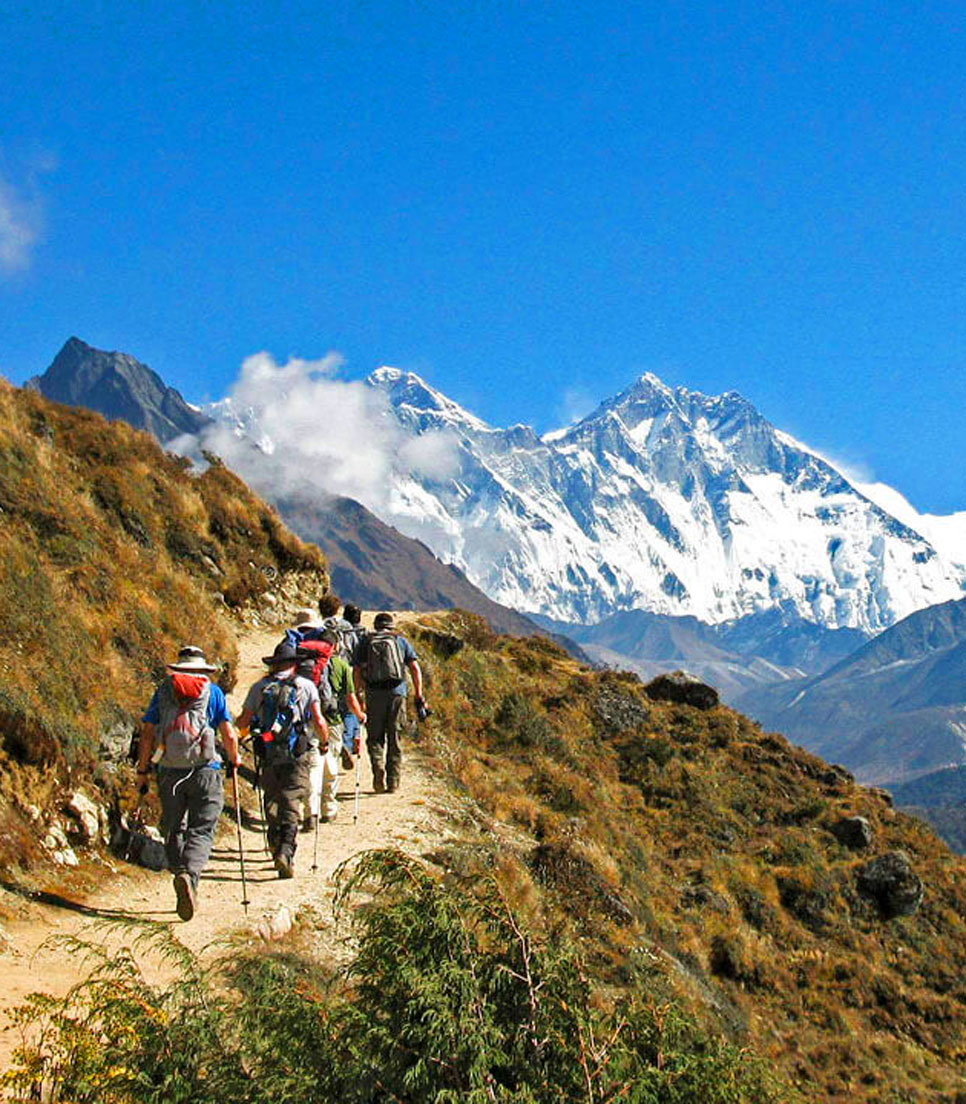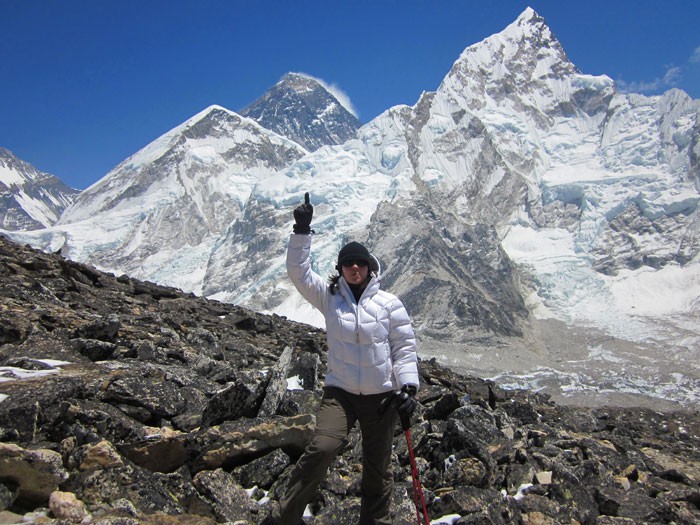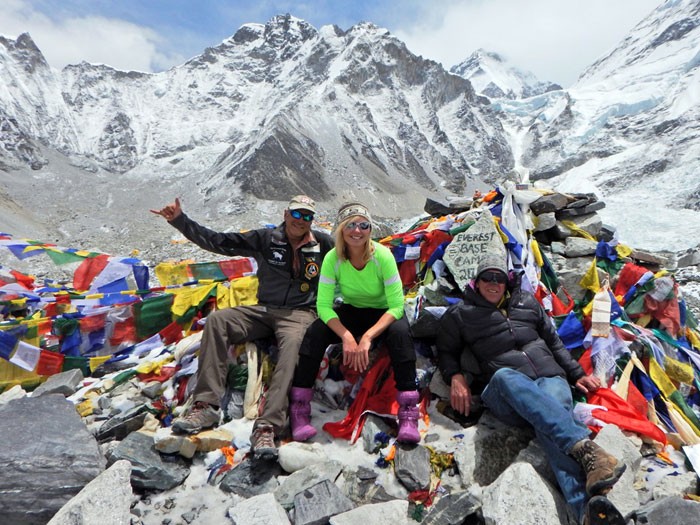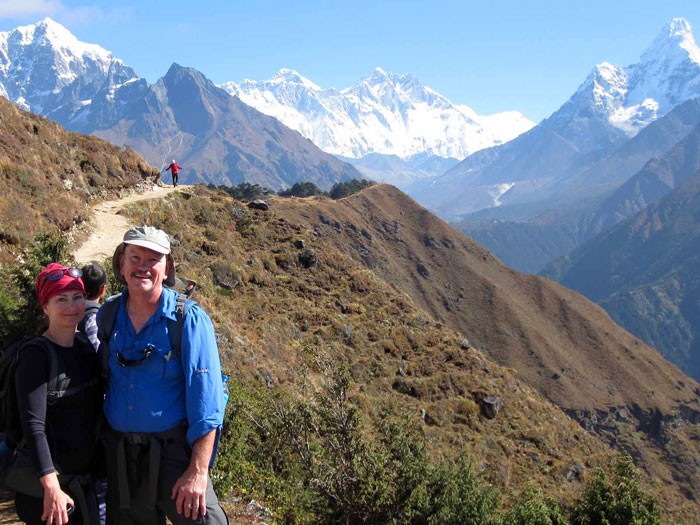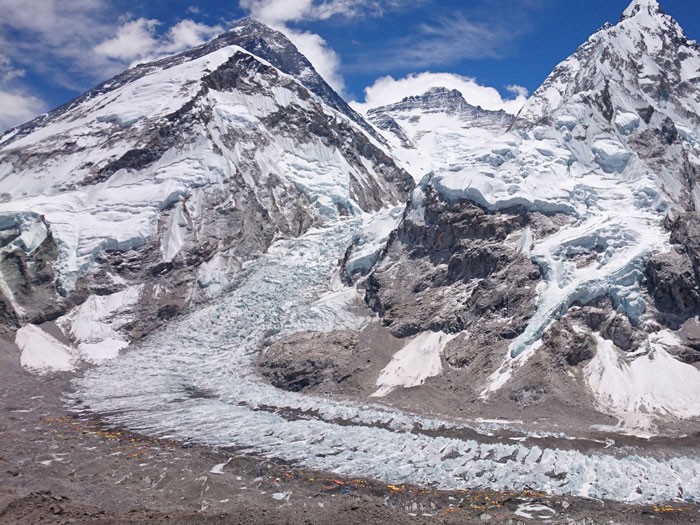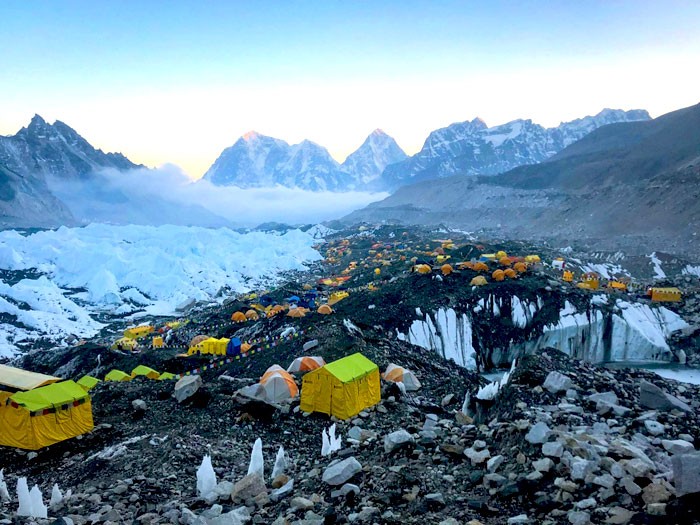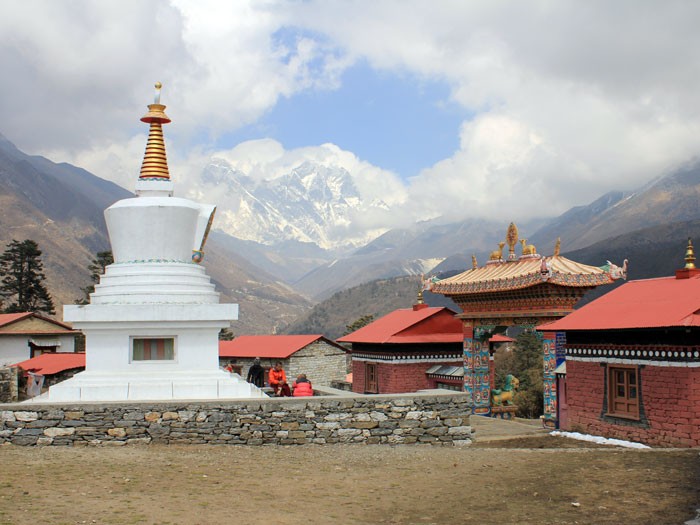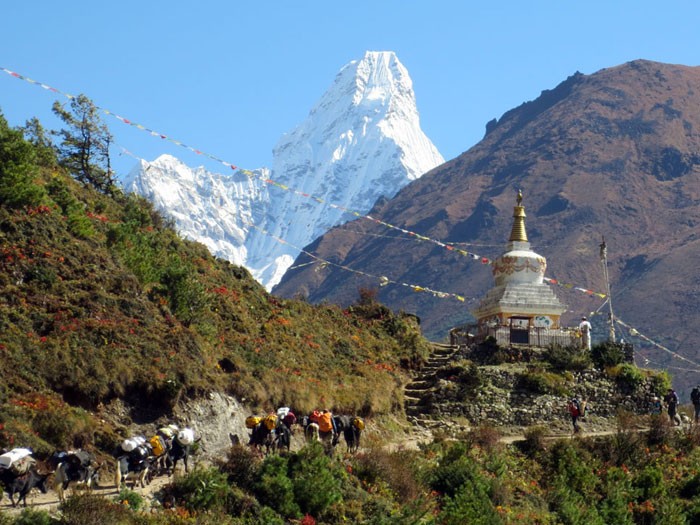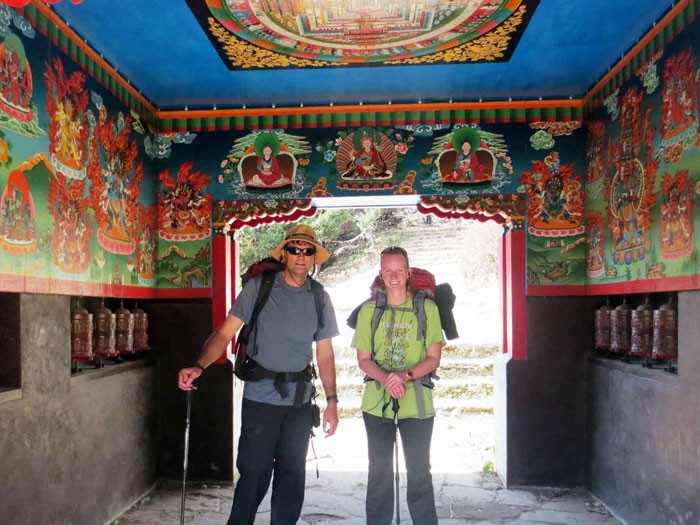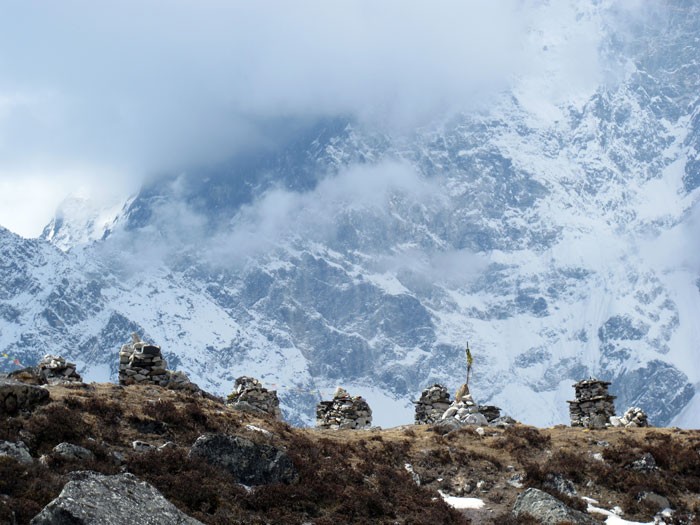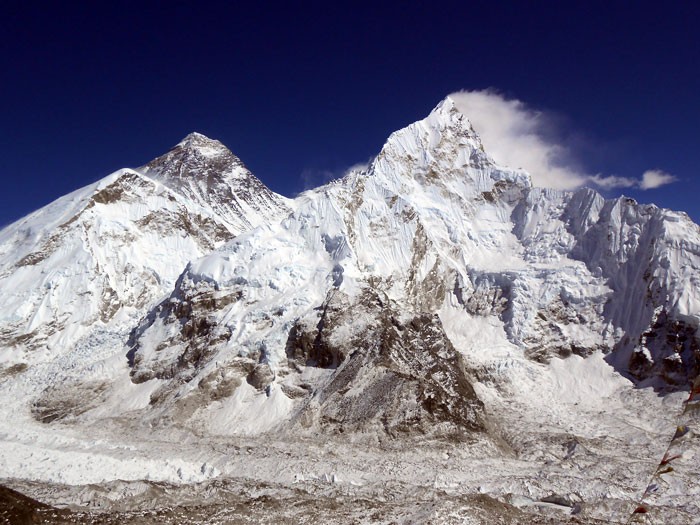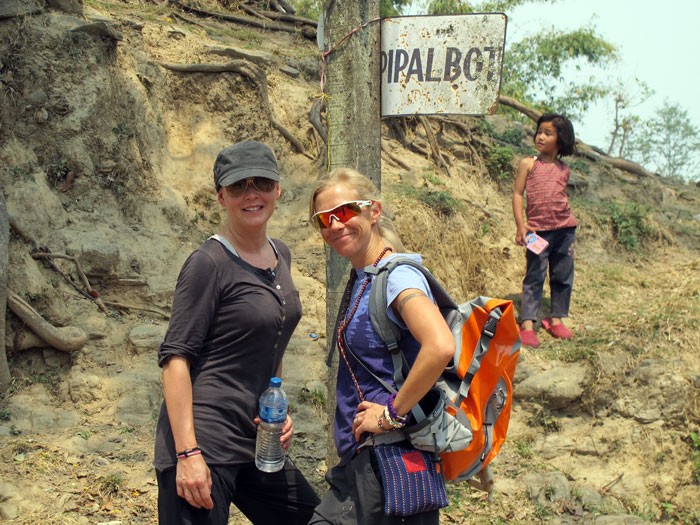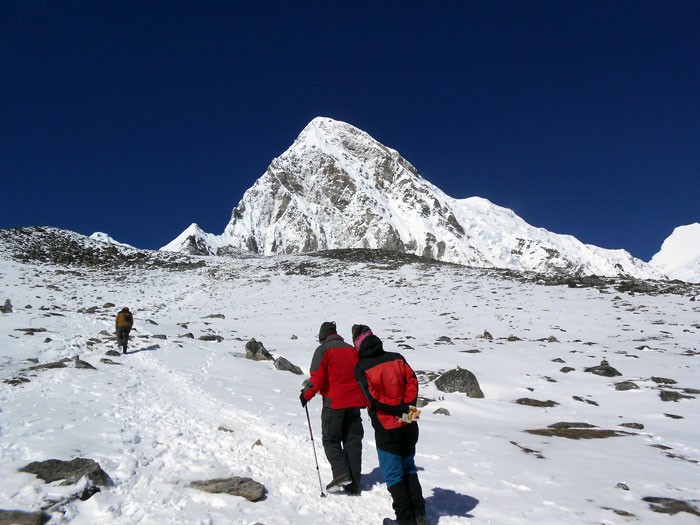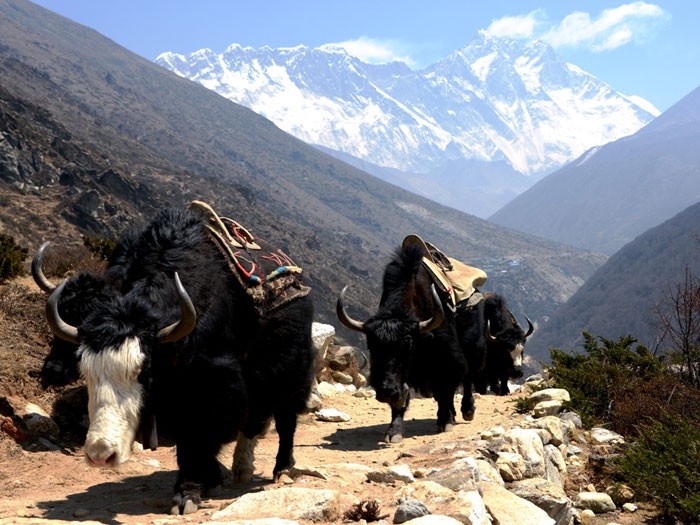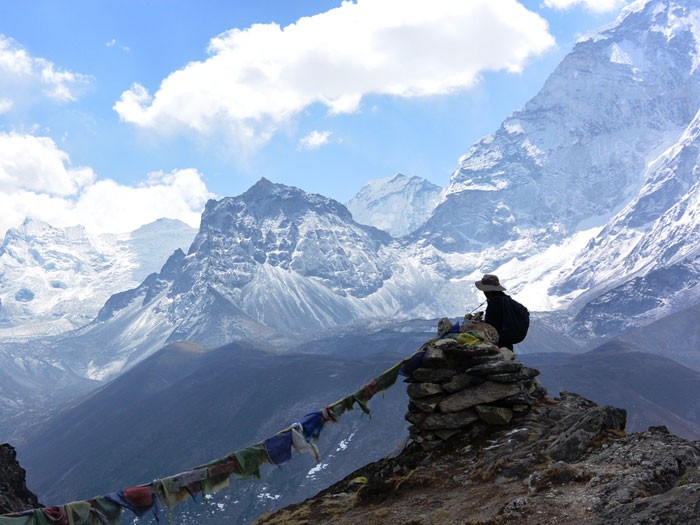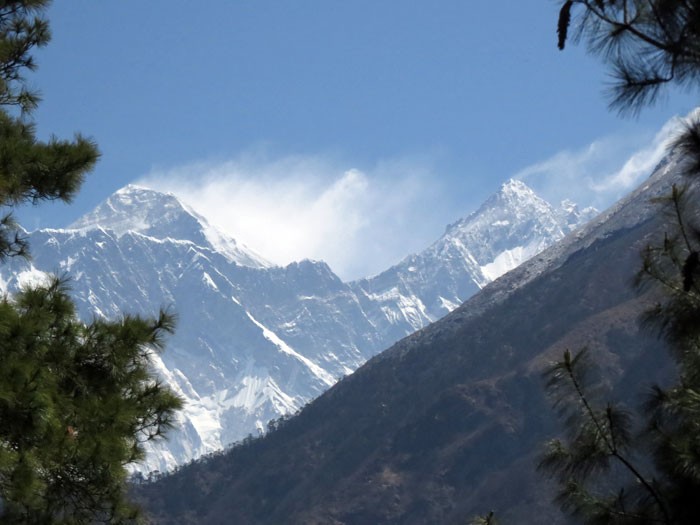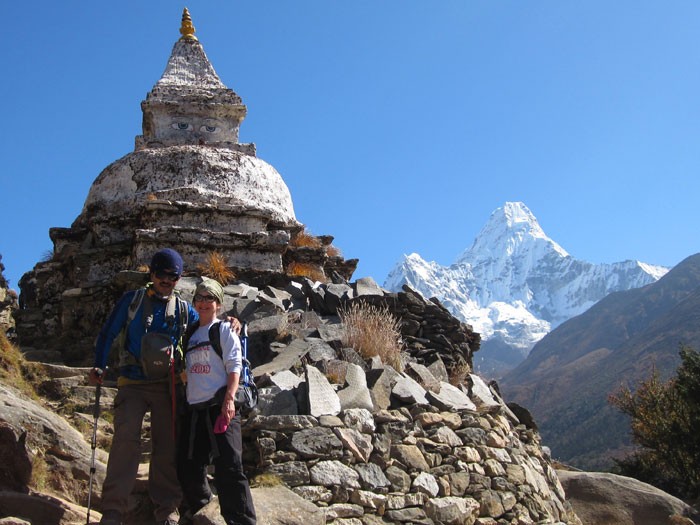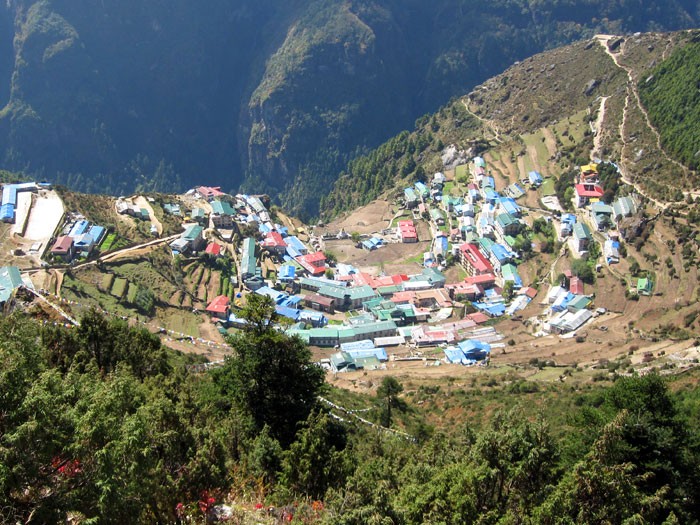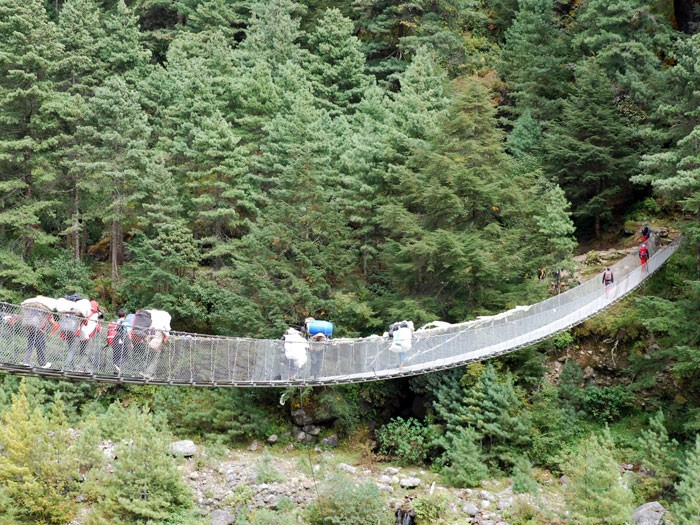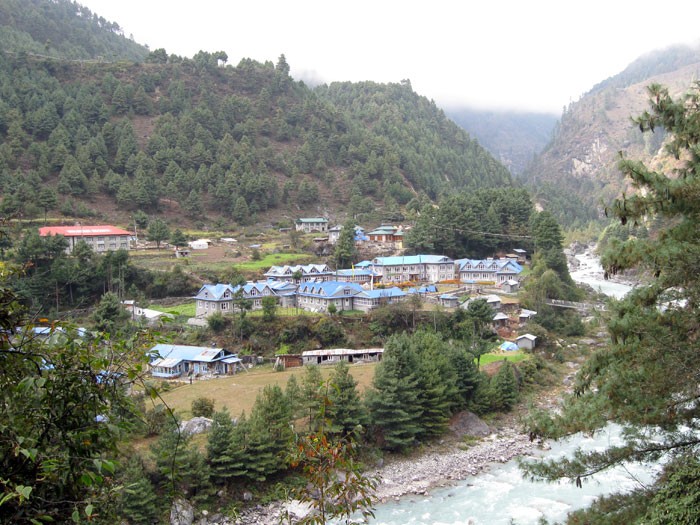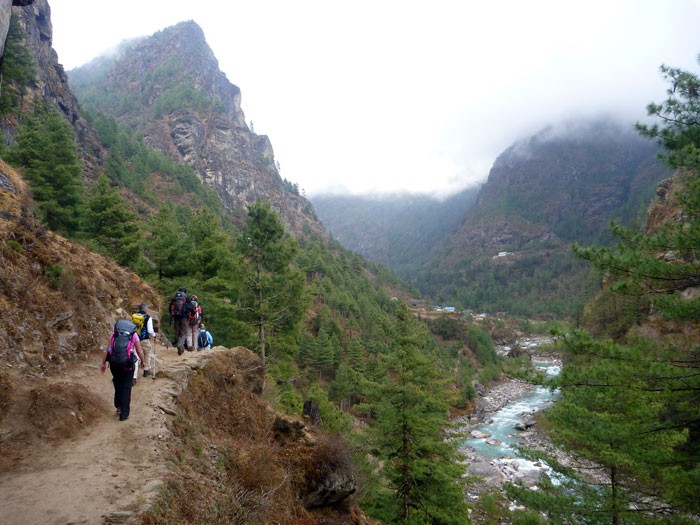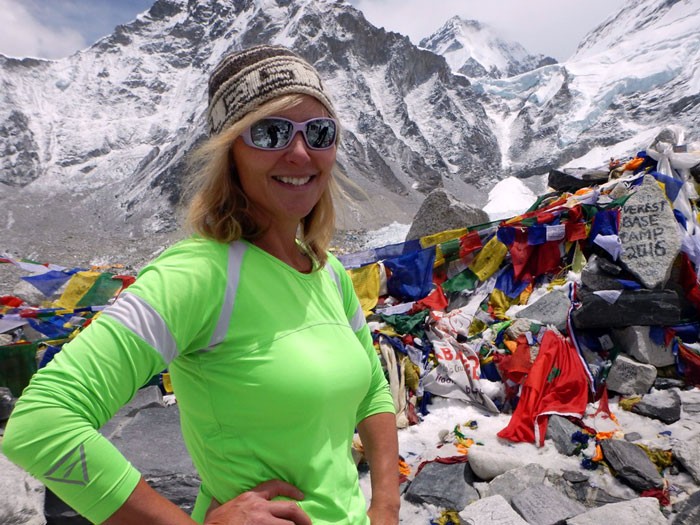Everest Base Camp Trek
Everest Base Camp Trek
2024 and 2025 Dates: 8 April to 24 April OR 20 April to 6 May OR 1 November to 17 November and 3 January to 19 January .OR 7 February to 23 February OR 7 March to 23 March OR 17 Days in Nepal (Other dates available throughout the year. Call for more info) Optional Island Peak add on
Full Service Cost: $2,850, £2,350, €2,750. (fixed in USD)
Christmas and New Year EBC trek dates : 16 December 2024 to 2 January 2025 . Optional 4 day Island Peak add-on
Trek to world's most famous basecamp. Enjoy a beautiful walk to Everest with our friendly team in January, April, November and December . Trips led and organized by Dan Mazur, 12 time Everest Expedition leader.
Try our Christmas Everest Trek
Recent News: Please click here . Please contact us now to book: info@summitclimb.com .
Mt. Everest was first climbed in 1953 by Hillary and Tenzing. Their base camp was at GorakShep which we will visit along our adventure. Our trek to the base of the highest mountain in the world allows you to enjoy the incredible beauty of Nepal and walk to a very high altitude on good snow-free paths, providing spectacular views of Everest and the surrounding Himalaya giants. The trip includes a day hike to the top of Kala Patthar; where some of the most famous pictures of Everest have been taken.
Everest Base Camp Video by Mario H.
- Sir Edmund Hillary and Tenzing Norgay Sherpa climbed Mount Everest in 1953 and they used this route to reach Everest Base Camp (EBC). Thus, EBC trekkers are literally “following in the footsteps” of the greats: Hillary and Tenzing.
- EBC is the Original Trek. The word “Trek” was popularized by British Army Nepal Gurkha Regiment Colonel James Roberts in the late 1950s when he envisioned that foreign travelers would enjoy walking through picturesque farming villages and sleeping in the comfortable stone homes of local Sherpa families, as the tourists walked to the first ascent base camp at the foot of Mt Everest. Since then, the trek has become incredibly popular and the villages and accommodations along the route have developed to a high standard.
- No Other Trek in the World Can Offer This Ultimate Destination: The world’s most iconic basecamp at our Earth’s Highest Point
- Friendly People. Nepalese people are very warm and friendly, and the Interesting Sherpas who Live in the Everest Region have a fascinating culture and society, so well adapted to the Khumbu Everest Region, and they are especially grateful for your visit and are comfortable being around foreign people. In fact, many Sherpas have relatives living, working and going to school in other countries.
- Amazing Famous Mountains Along the Trek. Not only can you see Everest, but many other stunning mountains like Ama Dablam, Lhotse, Thamserku, Tawoche, Pumori, Nuptse, and so many others. There really are few other spots in the world to see this amount of peaks in such a short time.
- Tims cart -$20
- National park – $33
- Pasalng lamu -$20
Our full-service expedition includes:
- British, European, or American trip coordinator
- Expert Sherpa Guide
- Gear check in Kathmandu and guided shopping at the gear hire / purchase shops
- Round trip return transport from KTM-Lukla and Lukla-KTM.
- Full service teahouse trek to / from basecamp
- Yak and porter transport of all your equipment during each day of the trek
- Three meals each day
- Trek permits and National park fees
- Two nights stay in a clean comfortable conveniently located Kathmandu hotel on arrival and two nights prior to departure in a double room. Private rooms are available for a small additional fee.
- Airport transfers
What is not included?
- International flights to/from Kathmandu
- Mountain climbing rescue and travel insurance
- Personal climbing equipment and clothing
- Gratuities for staff
- Nepalese visa
- Can I spend extra nights in basecamp if I wish?
- Can I charge my electrical devices whilst on the trek?
- Sir Edmund Hillary and Tenzing Norgay Sherpa climbed Mount Everest in 1953 and they used this route to reach Everest Base Camp (EBC). Thus, EBC trekkers are literally “following in the footsteps” of the greats: Hillary and Tenzing.
- EBC is the Original Trek. The word “Trek” was popularized by British Army Nepal Gurkha Regiment Colonel James Roberts in the late 1950s when he envisioned that foreign travelers would enjoy walking through picturesque farming villages and sleeping in the comfortable stone homes of local Sherpa families, as the tourists walked to the first ascent base camp at the foot of Mt Everest. Since then, the trek has become incredibly popular and the villages and accommodations along the route have developed to a high standard.
- No Other Trek in the World Can Offer This Ultimate Destination: The world’s most iconic basecamp at our Earth’s Highest Point
- Friendly People. Nepalese people are very warm and friendly, and the Interesting Sherpas who Live in the Everest Region have a fascinating culture and society, so well adapted to the Khumbu Everest Region, and they are especially grateful for your visit and are comfortable being around foreign people. In fact, many Sherpas have relatives living, working and going to school in other countries.
- Amazing Famous Mountains Along the Trek. Not only can you see Everest, but many other stunning mountains like Ama Dablam, Lhotse, Thamserku, Tawoche, Pumori, Nuptse, and so many others. There really are few other spots in the world to see this amount of peaks in such a short time.
- Tims cart -$20
- National park – $33
- Pasalng lamu -$20
1) Arrive in Kathmandu
2) Orientation
3) Fly from Kathmandu to Lukla 2,840 meters/9,318 feet. Trek to Phakding, where we stay at a teahouse, 2650 meters/8,694 feet.
4) Walk to Namche Bazaar 3,440 meters/11,286 feet.
5) Rest, acclimate, and relax in Namche Bazaar.
6) Trek to Pangboche, 3,985 meters / 13,074 foot.
7) Walk along to the village of Dingboche, 4,410 meters / 14,469 feet.
8) Rest in Dingboche.
9) Walk to the village Lobuche, 4,930 meters/16,175 feet.
10) Walk to GorakShep, at 5,160 meters/16,929 feet for lunch, then trek up Kala Patar, 5,545 meters/18,192 feet.
11) Walk up to Everest basecamp, which lies atop the Khumbu glacier at 5,300 metres/17,388 feet. Return to GorakShep.
12) Walk to Pheriche.
13) Walk back to Namche Bazaar.
14) Walk to Lukla.
15) Return flight to Kathmandu.
16) Extra day of rest and celebration in Kathmandu.
17) Flight home.
- Sir Edmund Hillary and Tenzing Norgay Sherpa climbed Mount Everest in 1953 and they used this route to reach Everest Base Camp (EBC). Thus, EBC trekkers are literally “following in the footsteps” of the greats: Hillary and Tenzing.
- EBC is the Original Trek. The word “Trek” was popularized by British Army Nepal Gurkha Regiment Colonel James Roberts in the late 1950s when he envisioned that foreign travelers would enjoy walking through picturesque farming villages and sleeping in the comfortable stone homes of local Sherpa families, as the tourists walked to the first ascent base camp at the foot of Mt Everest. Since then, the trek has become incredibly popular and the villages and accommodations along the route have developed to a high standard.
- No Other Trek in the World Can Offer This Ultimate Destination: The world’s most iconic basecamp at our Earth’s Highest Point
- Friendly People. Nepalese people are very warm and friendly, and the Interesting Sherpas who Live in the Everest Region have a fascinating culture and society, so well adapted to the Khumbu Everest Region, and they are especially grateful for your visit and are comfortable being around foreign people. In fact, many Sherpas have relatives living, working and going to school in other countries.
- Amazing Famous Mountains Along the Trek. Not only can you see Everest, but many other stunning mountains like Ama Dablam, Lhotse, Thamserku, Tawoche, Pumori, Nuptse, and so many others. There really are few other spots in the world to see this amount of peaks in such a short time.
- Tims cart -$20
- National park – $33
- Pasalng lamu -$20
Sherpas: We employ some of Nepal, Tibet, and the Karakorum’s best local mountaineers and Sherpas to assist team members in realizing their summit goals. Our friendly and loyal high altitude climbing staff has supported teams to the summits of more than ten of the highest peaks in the Himalaya.
- Sir Edmund Hillary and Tenzing Norgay Sherpa climbed Mount Everest in 1953 and they used this route to reach Everest Base Camp (EBC). Thus, EBC trekkers are literally “following in the footsteps” of the greats: Hillary and Tenzing.
- EBC is the Original Trek. The word “Trek” was popularized by British Army Nepal Gurkha Regiment Colonel James Roberts in the late 1950s when he envisioned that foreign travelers would enjoy walking through picturesque farming villages and sleeping in the comfortable stone homes of local Sherpa families, as the tourists walked to the first ascent base camp at the foot of Mt Everest. Since then, the trek has become incredibly popular and the villages and accommodations along the route have developed to a high standard.
- No Other Trek in the World Can Offer This Ultimate Destination: The world’s most iconic basecamp at our Earth’s Highest Point
- Friendly People. Nepalese people are very warm and friendly, and the Interesting Sherpas who Live in the Everest Region have a fascinating culture and society, so well adapted to the Khumbu Everest Region, and they are especially grateful for your visit and are comfortable being around foreign people. In fact, many Sherpas have relatives living, working and going to school in other countries.
- Amazing Famous Mountains Along the Trek. Not only can you see Everest, but many other stunning mountains like Ama Dablam, Lhotse, Thamserku, Tawoche, Pumori, Nuptse, and so many others. There really are few other spots in the world to see this amount of peaks in such a short time.
- Tims cart -$20
- National park – $33
- Pasalng lamu -$20
Upper Body:
- 1 cotton t-shirt
- 1 cotton long sleeved shirt
- 1 polypropylene warm but light thermal long shirt
- 1 fleece jacket
- 1 wind/waterproof jacket with hood
- Umbrella (optional)
Hands:
- 1 pair warm poly thermal gloves, with waterproof wind shell (the latter is optional)
Head:
- 1 cotton sun hat
- 1 scarf (optional)
- 1 fleece balaclava or warm hat
- 1 head torch/headlamp with extra batteries
- 2 pair underwear
- 1 pair walking shorts
- 1 pair long trousers
- 1 pair warm but light thermal leggings
- 1 pair fleece/pile pants
- 1 pair wind/waterproof pants
- 2 pair socks
- 1 pair sandals for use in hotel
- 2 pair medium weight wool socks
- 1 pairof sturdy, leather trekking boots ("broken-in" please)
- 1 pair trainers/lightweight running shoes for trekking on flat, easy trails
- Sleeping bag (good to -10 degrees C or 10 degrees F)
- Closed cell foam kari-mat/sleeping pad (optional).
- Medium backpack (40-60 liters)
- Waterproof rucksack cover (optional)
- 1 large kit-travel bag with lock (80-120 liters)
- Toothpaste and toothbrush
- Bar of soap and small towel
- Female or male hygiene supplies
- Earplugs
- Face Mask
- Hand sanitiser
- Disposable gloves
- Disinfectant wipes
Medical: Medications are inexpensive and readily available in Kathmandu without a prescription.
- Small personal first-aid kit: blister repair, first-aid tape, plasters/ Band-Aids, personal medications, etc. The leader will have an extensive first-aid kit.
- 10 anti-diarrhea pills (Imodium, Loperamide)
- 10 anti-headache pills (Paracetamol, Tylenol)
- 10 anti-inflammatory pills (Ibuprofen)
- 20 cough lozenges, cough sweets, Strepsils, Halls
- 1 small bottle anti-altitude sickness pills: Diamox, Acetylzolamide
- 10 stomach antibiotic pills: (Ciprofloxacin, Norfloxacin)
- 6 broad spectrum antibiotic pills: (Azithromycin)
- Do not bring sleeping pills. They are a respiratory depressant
- Steripen, bottle of water purification tablets, or water filter
- Small bottle of hand-sanitizer
- Sunscreen for skin and lips. At least 30SPF
Personal Food:
- We ask that you bring or buy your own "snack" or daily cold energy food. 2 kilos/4 pounds is a good amount.
- Bathing suit
- Trekking poles
- Glacier glasses
- 1 liter water bottle
- 1 small roll of repair tape
- Small multi-purpose knife
- Battery powered alarm clock/watch
- Camera, extra batteries, charging cords
- 4 large, waterproof, disposable rubbish sacks
- passport, 2 extra passport photos, flight ticket, flight itinerary
- separate photocopies of passport and relevant visa pages, proof of insurance
- Dollars, Pounds or Euros cash for purchasing Nepalese visa at Kathmandu airport, for paying for restaurants and hotels, for gratuities, snacks, and to purchase your own drinks and gifts
- Credit cards (bring a photocopy of your cards), traveler's checks, etc
- Contact lens supplies and an extra set of prescription glasses
- Sir Edmund Hillary and Tenzing Norgay Sherpa climbed Mount Everest in 1953 and they used this route to reach Everest Base Camp (EBC). Thus, EBC trekkers are literally “following in the footsteps” of the greats: Hillary and Tenzing.
- EBC is the Original Trek. The word “Trek” was popularized by British Army Nepal Gurkha Regiment Colonel James Roberts in the late 1950s when he envisioned that foreign travelers would enjoy walking through picturesque farming villages and sleeping in the comfortable stone homes of local Sherpa families, as the tourists walked to the first ascent base camp at the foot of Mt Everest. Since then, the trek has become incredibly popular and the villages and accommodations along the route have developed to a high standard.
- No Other Trek in the World Can Offer This Ultimate Destination: The world’s most iconic basecamp at our Earth’s Highest Point
- Friendly People. Nepalese people are very warm and friendly, and the Interesting Sherpas who Live in the Everest Region have a fascinating culture and society, so well adapted to the Khumbu Everest Region, and they are especially grateful for your visit and are comfortable being around foreign people. In fact, many Sherpas have relatives living, working and going to school in other countries.
- Amazing Famous Mountains Along the Trek. Not only can you see Everest, but many other stunning mountains like Ama Dablam, Lhotse, Thamserku, Tawoche, Pumori, Nuptse, and so many others. There really are few other spots in the world to see this amount of peaks in such a short time.
- Tims cart -$20
- National park – $33
- Pasalng lamu -$20
Extensive experience is not required for trekking to Everest Basecamp. The most important thing is for members to be in adequate walking fitness. You may attempt this trek as a novice and we will teach you what you need to know.
Prior to joining our group, please see your doctor and obtain the necessary permission and advice, as well as medications for travel in extremes of altitude, and also for exotic locales.
- Sir Edmund Hillary and Tenzing Norgay Sherpa climbed Mount Everest in 1953 and they used this route to reach Everest Base Camp (EBC). Thus, EBC trekkers are literally “following in the footsteps” of the greats: Hillary and Tenzing.
- EBC is the Original Trek. The word “Trek” was popularized by British Army Nepal Gurkha Regiment Colonel James Roberts in the late 1950s when he envisioned that foreign travelers would enjoy walking through picturesque farming villages and sleeping in the comfortable stone homes of local Sherpa families, as the tourists walked to the first ascent base camp at the foot of Mt Everest. Since then, the trek has become incredibly popular and the villages and accommodations along the route have developed to a high standard.
- No Other Trek in the World Can Offer This Ultimate Destination: The world’s most iconic basecamp at our Earth’s Highest Point
- Friendly People. Nepalese people are very warm and friendly, and the Interesting Sherpas who Live in the Everest Region have a fascinating culture and society, so well adapted to the Khumbu Everest Region, and they are especially grateful for your visit and are comfortable being around foreign people. In fact, many Sherpas have relatives living, working and going to school in other countries.
- Amazing Famous Mountains Along the Trek. Not only can you see Everest, but many other stunning mountains like Ama Dablam, Lhotse, Thamserku, Tawoche, Pumori, Nuptse, and so many others. There really are few other spots in the world to see this amount of peaks in such a short time.
- Tims cart -$20
- National park – $33
- Pasalng lamu -$20
Please fill out an application and return it to us with your refundable ten-percent deposit to hold your place on the team.
- Everest Nepal Trek for World Team Members (UK Office) : PDF Form or MS Word Doc
- Everest Nepal Trek for US Team Members (US Office) : PDF Form or MS Word Doc
In addition to your application, we will need the following at least two months before the trip begins:
- Completed Payment
- Oxygen order (if any)
- Sherpa order (if any)
- Trip Registration form
- 1 Passport sized photo
- A scan of your passport identification pages
- Complete flight itinerary
- Proof of travel, accident, and repatriation insurance. We strongly recommend Global Rescue, with at least $50,000 worth of helicopter rescue insurance.
- Trip cancellation/interruption insurance is recommended
Please contact us with any questions you may have.
- Sir Edmund Hillary and Tenzing Norgay Sherpa climbed Mount Everest in 1953 and they used this route to reach Everest Base Camp (EBC). Thus, EBC trekkers are literally “following in the footsteps” of the greats: Hillary and Tenzing.
- EBC is the Original Trek. The word “Trek” was popularized by British Army Nepal Gurkha Regiment Colonel James Roberts in the late 1950s when he envisioned that foreign travelers would enjoy walking through picturesque farming villages and sleeping in the comfortable stone homes of local Sherpa families, as the tourists walked to the first ascent base camp at the foot of Mt Everest. Since then, the trek has become incredibly popular and the villages and accommodations along the route have developed to a high standard.
- No Other Trek in the World Can Offer This Ultimate Destination: The world’s most iconic basecamp at our Earth’s Highest Point
- Friendly People. Nepalese people are very warm and friendly, and the Interesting Sherpas who Live in the Everest Region have a fascinating culture and society, so well adapted to the Khumbu Everest Region, and they are especially grateful for your visit and are comfortable being around foreign people. In fact, many Sherpas have relatives living, working and going to school in other countries.
- Amazing Famous Mountains Along the Trek. Not only can you see Everest, but many other stunning mountains like Ama Dablam, Lhotse, Thamserku, Tawoche, Pumori, Nuptse, and so many others. There really are few other spots in the world to see this amount of peaks in such a short time.
- Tims cart -$20
- National park – $33
- Pasalng lamu -$20
- Sir Edmund Hillary and Tenzing Norgay Sherpa climbed Mount Everest in 1953 and they used this route to reach Everest Base Camp (EBC). Thus, EBC trekkers are literally “following in the footsteps” of the greats: Hillary and Tenzing.
- EBC is the Original Trek. The word “Trek” was popularized by British Army Nepal Gurkha Regiment Colonel James Roberts in the late 1950s when he envisioned that foreign travelers would enjoy walking through picturesque farming villages and sleeping in the comfortable stone homes of local Sherpa families, as the tourists walked to the first ascent base camp at the foot of Mt Everest. Since then, the trek has become incredibly popular and the villages and accommodations along the route have developed to a high standard.
- No Other Trek in the World Can Offer This Ultimate Destination: The world’s most iconic basecamp at our Earth’s Highest Point
- Friendly People. Nepalese people are very warm and friendly, and the Interesting Sherpas who Live in the Everest Region have a fascinating culture and society, so well adapted to the Khumbu Everest Region, and they are especially grateful for your visit and are comfortable being around foreign people. In fact, many Sherpas have relatives living, working and going to school in other countries.
- Amazing Famous Mountains Along the Trek. Not only can you see Everest, but many other stunning mountains like Ama Dablam, Lhotse, Thamserku, Tawoche, Pumori, Nuptse, and so many others. There really are few other spots in the world to see this amount of peaks in such a short time.
- Tims cart -$20
- National park – $33
- Pasalng lamu -$20
